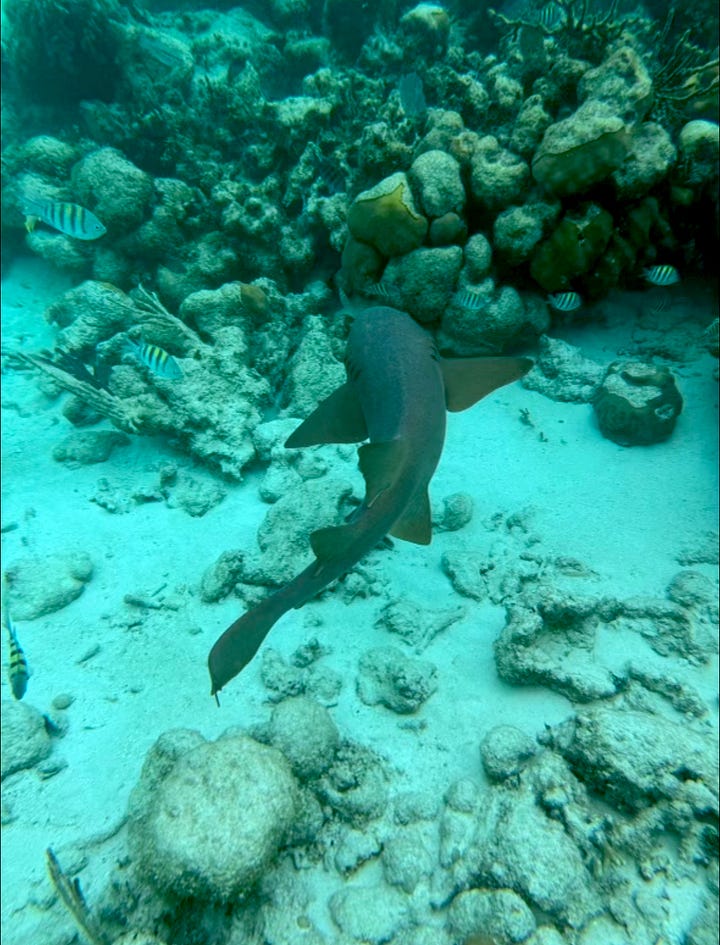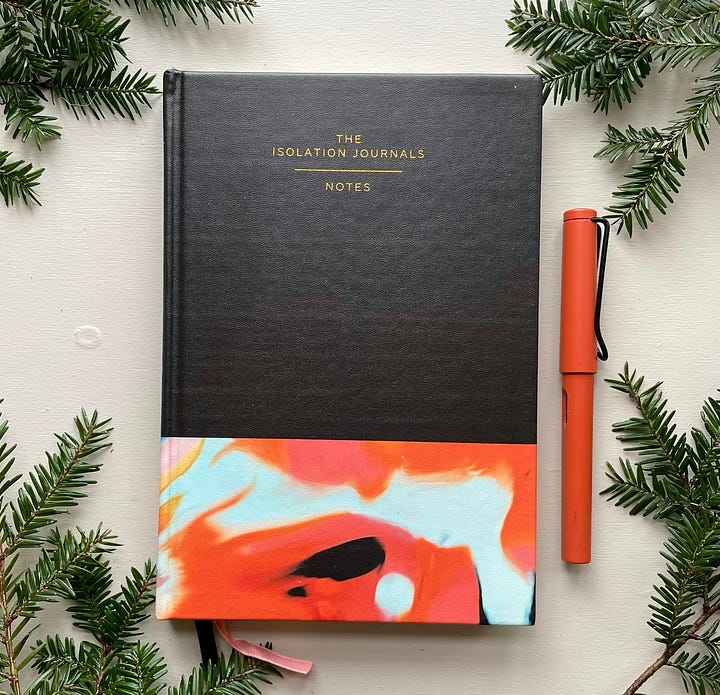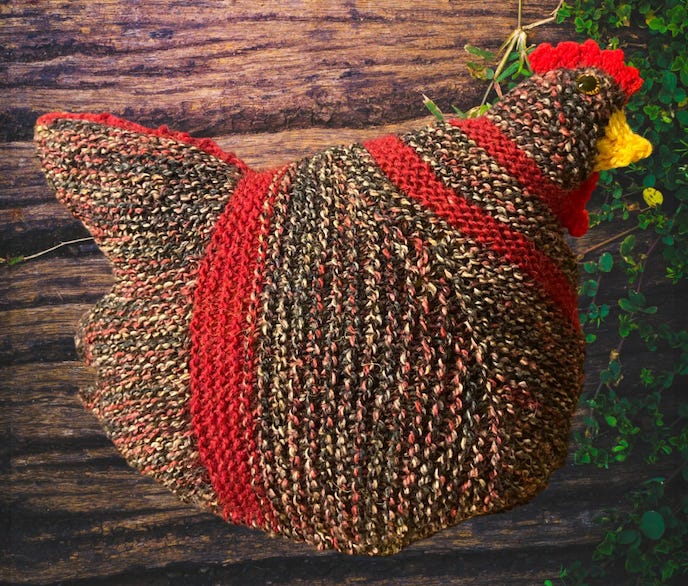Prompt 315. Swimming with Sharks
& Linda Gallalee on chickens and emotional support
Hi friend,
I spent my Thanksgiving by the water. My husband Jon and I recently established a tradition of celebrating the holiday with my best friend Lizzie and her family—and not in the chilly Northeast, but somewhere warm and tropical. This year, we chose an island off the coast of Belize called Ambergris Caye, and my dad decided to join us. (My mom and brother are in Tunisia at the moment, or they would have joined us too.) Before we left, I did what I always do when I head to the beach: I googled the number of shark attacks and fatalities at said locale. The answer I got soothed my anxiety. There’s only one known shark attack on the books, and fortunately it wasn’t fatal.
I’ve had an outsized fear of sharks since I was young. I remember clearly the terror I felt the first time I saw Jaws—but even before that, I feared what lurked beneath the surface, whether in a pond, a lake, or the ocean. If I can’t see bottom, I start to imagine some predator making a beeline toward me from the watery depths and I panic. If even a piece of seaweed caresses my ankle, I scream bloody murder and won’t get back into the water for the rest of the trip. The fear of what lies beneath is great fodder for psychoanalysis, of course—it’s hard not to read it as a fear of what might come for you when your defenses are down. But the water surrounding Ambergris Caye was an unbelievably vibrant aquamarine and crystal clear, and I was calm and collected wading in.
Then one morning, the others suggested snorkeling, which sounded fun. We all headed down to a little beach hut to meet with a guide and to get the necesssary gear—flippers, lifejackets, and snorkeling masks, kayaks and oars for paddling out to some distant reef. Then I asked the guide what we could to expect to see.
“All kinds of fish,” he said. “And also giant sting rays and sharks.”
I felt myself freeze. “What do you mean sharks?”
“Nurse sharks,” he replied, “and barrier reef sharks.”
“How big?” I asked. Panic was setting in.
“The reef sharks can get up to six feet, but they’re not dangerous—and it’s highly unlikely you’ll see any of the dangerous ones,” he said.
I could feel my face going cartoonish—eyes wide as saucers, mouth agape. But I’m the kind of person who wants to know everything—all the possibilities and worst-case scenarios—so I asked him to give me some details. To my terror and surprise, he did. He listed a number of specific incidents, like the man who stepped on a sting ray while fishing and had to be rushed to urgent care.
“Just don’t touch the sharks,” he said—as if there was a chance I was going to! He went on to explain that he enjoys grabbing the nurse sharks and tickling their bellies. They don’t have teeth, he said, but they have powerful suction. Then he showed me two scars on his arm. “Be cool,” he said. And again, “Don’t touch the sharks.”
It’s hard to overstate how unnecessary that instruction was. It’s also hard for me to explain how, after such a conversation, I got myself into the kayak and began paddling out toward a far-away buoy. Or how, after arriving at the buoy, and finding two boats anchored, throwing chum in the water, trying to attract even more sharks, I found my way into the water.
I think it may have helped that Jon was even more scared than I was—not of dangerous sea creatures, but of the water itself, courtesy of a near-drowning incident in childhood. It was as if I became attendant to his terror rather than focused on my own. Jon had my hand in an absolute death grip, and he had Lizzie’s in the other, and he was screaming through his snorkel in a bizarre whale moan. “Jon, stop screaming!” I said. “What if the sharks hear it and take it as some kind of call?”
And then, somehow, panicked as we were, linked up like some three-bodied superhuman, we began to snorkel. It took some trial and error, accidentally gulping down sea water, and me reminding Jon to get his flippers off the floor of the ocean—to float, not to stand—but we did it. Just feet below us were beautiful glinting fish, and also dozens of sharks and enormous sting rays. It was terrifying, but I had been given a specific instruction: when you see a shark, you may want to scream and start paddling away from them frantically, but you’re supposed to do the opposite; you’re supposed to stay calm and float. It’s completely counterintuitive until you do it, and then it’s absolutely intuitive. It seemed to mirror my approach to all of the many fears I have swirling in my head—which is not to fight or try to change my reality, but to float and flow with the current.
As panicked as I was at first, it was one of the top life experiences I’ve ever had—to learn to breathe, to learn to float, to coexist long enough to really see the sharks and rays, to admire their beauty and grace. They were stunning, and it made me want to paint them, especially the sting rays. To my own great shock, the very next day, I suggested we go again. And everyone agreed, so that’s what we did for the rest of the trip. Every day, we went for a swim with sharks. It was an unexpected joy, and even an unexpected comfort.


Which brings me to today’s essay and prompt—from a longtime community member named Linda Gallalee. Linda joined the Isolation Journals back in April of 2020, in the early days of the pandemic, when she (like so many others) was struggling with what to do in the face of so much fear and uncertainty. When she saw a clip of Jon on The Late Show urging people to “google the Isolation Journals,” she did, and she felt it was exactly what she needed. She began journaling with us, and she hasn’t missed a day since.
Her essay and prompt was adapted from one of those entries. It’s called “Something About a Chicken,” and like so much of Linda’s writing, it’s wry and earnest and utterly heartwarming. May it comfort you like Yolko Ono does for Linda. (You’ll see.)
Sending love,
Suleika
Some items of note—
Our next meeting of the Hatch, our virtual creative hour for paid subscribers, is happening next Sunday, December 15 from 1-2 pm ET. is hosting this time, sharing thoughts on channeling the muse. It’s the warmest, most rewarding hour, and I hope you can make it live to see for yourself. But if not, don’t worry—we’ll post a video replay so you can take part whenever works for you.
Prompt 315. Something About a Chicken by Linda Gallalee
Yolko Ono was my first Emotional Support Chicken. I didn’t come up with her name, but I don’t mind it. Six months ago, all knitters were buzzing about ESCs. No fewer than three of the shops and bloggers I follow conducted Knit-a-longs for this pattern. If you happen to be a knitting history buff, you might like to know that the current pattern by Annette Corsino is an adaptation of an original pattern from 1997 called Henrietta and Friends by the late Bev Galaskas. (Intellectual property rights to knitting patterns are a huge deal.) The original Henrietta was felted; felting was what Bev did.
Even though I was knitting a baby blanket on deadline, I took a few days off to make Yolko Ono. I was having my gallbladder removed in a few weeks, and I needed an Emotional Support Chicken. A shop called The Knitting Tree L.A. put together the official Emotional Support Chicken Kit™, including yarn, instructions, stitch markers, stickers, and safety eyes. The eyes sold it for me. When I looked deep into those beady plastic eyes, I knew that I would not be diving into stash for yarn and using buttons or embroidered eyes. I bought the kit.
Yolko Ono has a secret: Her insides are more valuable than her outside. She is stuffed, not with polyester fiberfill, but rather with the finest Romney wool roving that money can buy. (Roving is made up of fibers that are processed and ready to felt or spin into yarn.) A few years ago I was charmed by the opportunity to buy wool roving that came directly from one of the sheep of a blogger that I follow. When the bag arrived, it was one of those “What was I thinking?” moments. The wool had been dyed a yellow pea soup color. I shuddered and stuck it on a shelf. But I’ll tell you what—when my chicken kit arrived, that roving was the first thing I thought of for stuffing. I submit that roving turns stuffing into an art form. Also, it’s kind of fun to think of a hen stuffed with fiber that came from a sheep.
I’m knitting at least five Emotional Support Chickens in advance of Christmas. Most are gifts. I’m also knitting Blue Gray Chicken for myself (I did come up with that name) to be my ESC in South Dakota. Times are challenging for me, and I know I’m not alone in that.
Right after my surgery I didn’t want to do anything more than sleep in a hospital chair clutching Yolko Ono. My husband was right there and I know he was perturbed at the implication that he wasn’t “enough” emotional support. I tried to explain. I was so grateful that he was with me. But sometimes you just need a chicken.
Your prompt for the week:
What or whom do you reach for when you need emotional support? Write about it—even if it's silly or frivolous.
If you’d like, you can post your response to today’s prompt in the comments section, in our Facebook group, or on Instagram by tagging @theisolationjournals. As a reminder, we love seeing your work inspired by the Isolation Journals, but to preserve this as a community space, we request no promotion of outside projects.
Today’s Contributor—
Linda Gallalee is a published author. In 1983 she co-wrote with her boss (i.e., wrote practically all of) a scholarly article about Insurance Agents Errors and Omissions Coverage for the CPCU Journal. In 1990 that article was a footnote in a Taiwanese dissertation entitled “A Comparative Study of Insurance Broker System Between Taiwan and China.” Linda is happily retired and splits her time between Chicago, Illinois, and Rapid City, South Dakota, journaling, knitting, painting, and whatever else she feels like doing. At the moment she is seriously addicted to knitting chickens.
For more paid subscriber benefits, see—
Survival as a Creative Act, a video replay of my Studio Visit from my painting residency, where I took questions from the community and gave a behind-the-scenes glimpse of my studio
Lighting the Way, an installment of my advice column Dear Susu, where I answer a question from a mother whose young son is on the eve of a second bone marrow transplant, asking for words of wisdom to see them through
On Joy, Sorrow, and Creative Alchemy, a replay of my workshop with the bestselling author Susan Cain, where we talked about accepting life’s sorrows, how they deepen the joys, and how, if we’re open and curious, we can find a creative practice that helps us marry the two


Some gift ideas for the holidays—
If you’re looking for a gift for a loved one this holiday season, consider our limited edition custom journal! It’s the perfect size to tote around, has ink-bleed proof paper and numbered pages for easy indexing. We even printed our Isolation Journals manifesto on the flyleaf. Get yours today!
Or give yourself or a loved one a future gift and preorder The Book of Alchemy! In this book—which comes out on April 22, 2025—I share everything I’ve learned about how journaling can help us transform life’s interruptions and tap into that mystical trait that exists in every human: creativity.













I may regret writing this, making this public, and revealing, even to myself, that after all these years, I found a car that is “cute”, and, worthy of being given a name. My older used car was recently declared too expensive to repair and continue driving. I have very recently been searching for a newer, younger, used car. A couple of weeks ago I believe I found The Car for me. I’ve always resisted feeling affectionate towards a car. Naming the car was out of the question. Until this car came along. I am enjoying the size, fairly small, compact, the color, a delicious blue-green, how the car feels while driving; I’ve never enjoyed driving a car. And, at this point in my life I am enjoying an automatic transmission. After years of stick shifts. No more clutch. I am still amazed that I can stay in Drive through all sorts of conditions. Anyhow, a few days ago someone asked me “are you going to name this car?” At first I resisted such a decision. Then, to my great surprise I realized with affection that this particular car deserved a name. I named the car after my sister and our maternal grandfather. So, though I shudder a bit, my emotional support(there are others) is currently Jesse, my little gem of a car. This may not be politically and socially correct, but here goes: when I was asked is the car a he or she, I quickly responded with “they”. That they is. 🏮
I love this idea a lot! I think we all need (especially these days, fraught as they are) emotional support of some kind, and some days, there is no "alive" thing that is up to the task. What then? An ESC. may come in very handy! Suleika, your words, "It seemed to mirror my approach to all of the many fears I have swirling in my head—which is not to fight or try to change my reality, but to float and flow with the current" reminds me of a concept I learned intuitively when I was struggling with panic disorder and major depression back in the 1970s, and then later, as a psychotherapist, learned as a concept that had been highly researched. "Radical Acceptance," helped me back then and still today. Pushing away fear or sadness only strengthens it's hold. "Floating through it helps release it and is a very powerful tool that increases recovery.